Table of Contents
Home / Blog / AI/ML
How To Develop An AI Application: A Detailed Guide
April 12, 2024
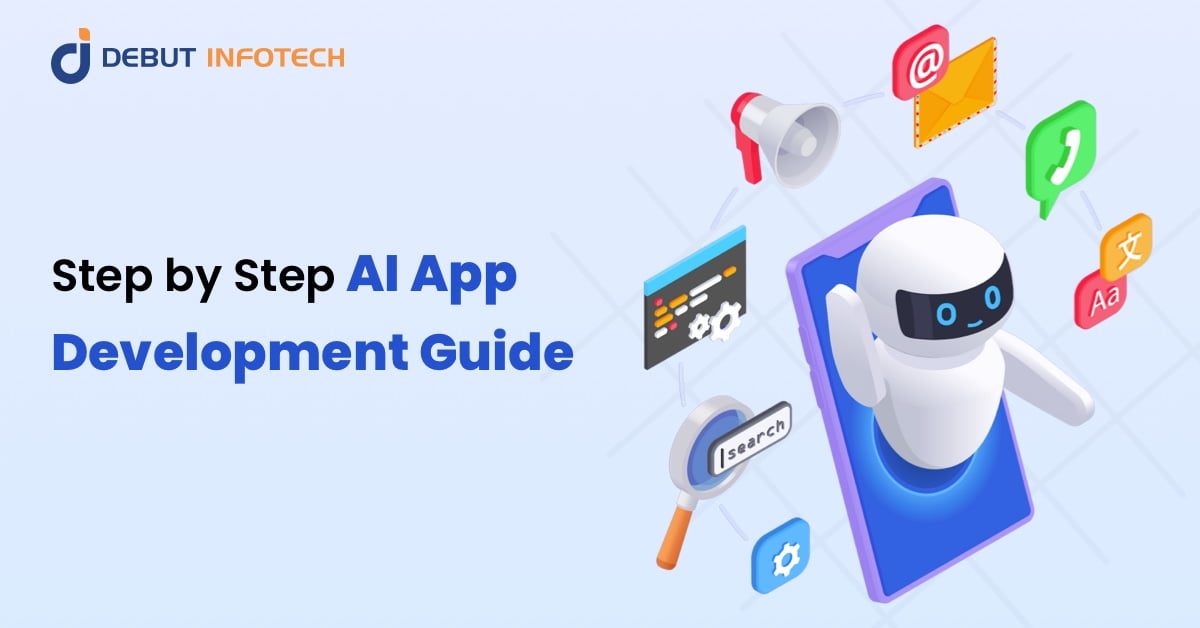
April 12, 2024
Enterprises that have successfully integrated artificial intelligence into their business operations have advanced their capabilities significantly. From precision-task robots to revolutionizing travel with autonomous vehicles, AI pervades our daily lives, from manufacturing units to smartwatches. Companies of all sizes and across industries now turn to AI to enhance customer satisfaction and drive sales, propelling it into the operational core of Fortune 500 companies for streamlined business automation. As businesses increasingly rely on AI, this trend will persist as customer service grows in importance. Consequently, the question arises: How does one go about building an AI application?
This article outlines the basics of AI and provides a detailed, sequential approach to build artificial intelligence apps. So, let’s get started.
Defining AI Technology In App Development
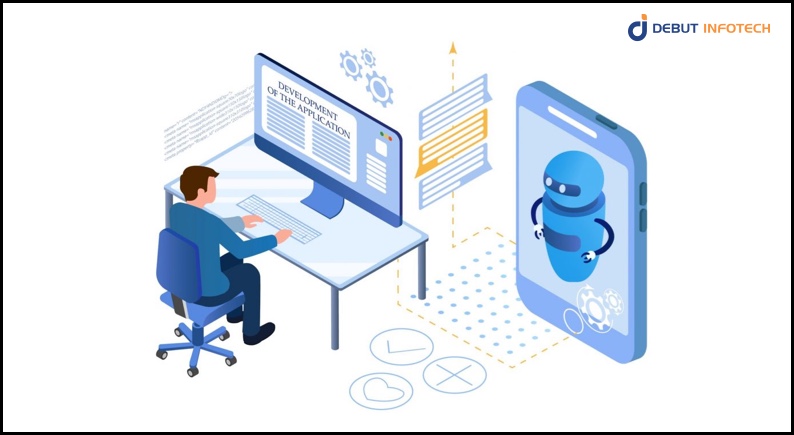
Artificial intelligence (AI) is a game-changing technology that is reinventing operations, transforming businesses across industries, and opening up previously unheard-of growth prospects. AI has enormous potential to increase profitability, productivity, and efficiency in a variety of ways, including by automating repetitive processes and forecasting customer behavior.
Organizations can obtain a competitive advantage by incorporating AI technology into their business strategy and using data-driven insights to make well-informed decisions. Following this, Businesses can analyze enormous volumes of data to spot trends, streamline workflows, and customize customer experiences by using machine learning algorithms.
Furthermore, AI-powered solutions streamline operations, reducing costs and enhancing scalability. Whether through chatbots providing instant customer support or predictive analytics optimizing supply chain management, AI empowers businesses to adapt and thrive in dynamic market landscapes.
However, successful AI implementation requires more than just technological investment. It demands a strategic approach, fostering a culture of innovation, and investing in talent capable of harnessing AI’s potential. By embracing AI, businesses can not only stay ahead of the curve but also pave the way for future growth and sustainability.
Artificial Intelligence Market Size and Industry Trends
Let’s have a look at commendable stats indicating the use of AI and demand for create an ai app:
- Statista projects the Artificial Intelligence market to reach more than US $305.90 billion by 2025.
- Next Move Strategy Consulting stated that the AI market will surge from $100 billion to nearly $2 trillion by 2030.
- MIT.edu reports over 50% of companies with 5,000+ employees and over 60% with 10,000+ use AI.
- Statista reports that the global AI market reached $142.3 billion in 2023.
- PWC stated that by November 2023, fifty-four percent of companies had integrated generative AI since ChatGPT’s release
- Organizations report that machines handle 34% of all business-related tasks as of 2023, according to the World Economic Forum.
- According to Statista’s 2023 data, businesses adopting AI can anticipate a revenue increase ranging from 6% to 10% on average.
- By August 2023, over 80% of Fortune 500 companies had incorporated ChatGPT into their operations, as reported by OpenAI.
- Statista’s 2023 findings indicate that one-fifth of all industries utilize artificial intelligence in service operations and corporate finance.
- The wearable AI market reached a valuation of $20 billion in 2023, as per Fact MR’s report.
What Are The Various Components Of AI Technology?

Artificial Intelligence technology consists of various essential elements, each of which is critical to the ability of robots to mimic human intelligence. Let’s examine each part in more detail:
Learning:
In AI, learning involves computer programs acquiring knowledge and skills through experience. This process mimics human learning but operates differently. AI learning often employs trial-and-error methods, where the program attempts various actions and learns from the outcomes. This learning, akin to rote learning, involves memorizing specific items like vocabulary and problem solutions. Later, the program applies this learned knowledge using a technique called generalization, allowing it to adapt to new situations.
Reasoning:
Reasoning enables AI to draw logical conclusions and make decisions based on available information. This component allows AI to infer relationships and make predictions relevant to a given situation. Reasoning can be classified into deductive and inductive reasoning. Deductive reasoning involves drawing specific conclusions from general principles, often successfully programmed into computers. Conversely, inductive reasoning deals with probabilistic cases, such as inferring causes from observed effects, which can be more complex.
Problem-solving:
AI’s problem-solving capability involves finding solutions to various challenges, ranging from basic to complex tasks. AI employs both general-purpose and special-purpose methods to tackle different problems. Tailored solutions, special-purpose methods address specific problems by leveraging relevant features. On the other hand, general-purpose approaches offer versatility, capable of solving a wide range of problems. AI’s problem-solving component gradually narrows the gap between desired goals and current states, iteratively working towards solutions.
Perception:
Perception enables AI to interpret and understand its environment using sensory inputs, similar to human perception. This component allows AI to analyze scenes, identify objects, and discern their relationships. Perception can be complex, as similar objects may appear differently based on viewing angles and conditions. For example, perception is crucial for self-driving cars to navigate roads safely and for robots to recognize and manipulate objects accurately.
Language Understanding:
Language understanding in AI involves comprehending human languages and executing commands. This component enables computers to understand natural language, like English, allowing seamless communication between humans and machines. AI is designed to interpret various types of language, including nuances and overstatements, to derive meaning accurately. This capability facilitates the execution of diverse computer programs and enhances human-computer interaction.
Related Read: How AI Development Services are Transforming the Digital Age
Understanding The Important Elements Of Artificial Intelligence
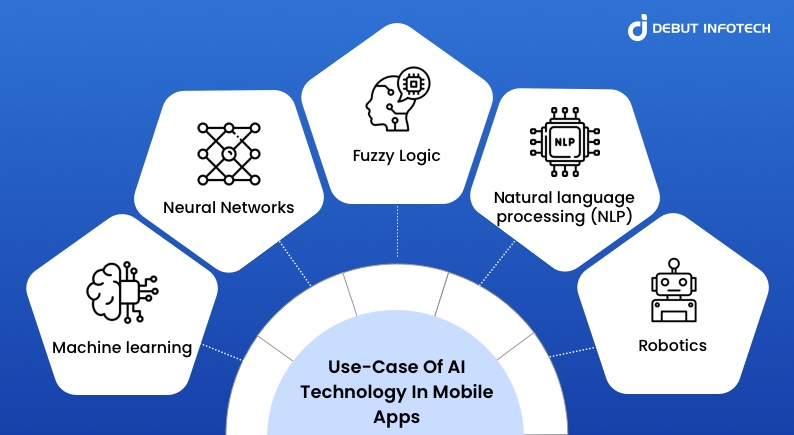
Artificial intelligence (AI) includes a variety of approaches and subfields, each fulfilling a specific purpose. Let’s break these elements down for a better understanding:
Machine Learning:
- Machine learning (ML) is a crucial aspect of advanced technology, often seen in new product introductions.
- ML allows computers to learn from data without explicit programming, finding applications in various real-life scenarios.
- It’s the science enabling machines to interpret, analyze, and act on data to solve real-world problems.
- Programmers use complex mathematical knowledge to design ML algorithms, written in machine-readable languages, forming complete ML systems.
- ML deciphers, categorizes, and estimates data from datasets, driving innovations like self-driving cars and speech recognition.
- ML focuses on applications that adapt and improve decision-making over time through experience.
Types of Machine Learning Algorithms:
Supervised Learning:
- Uses labeled training data to find correlations between inputs and outputs.
- Input and output variables are specified, allowing algorithms to learn from examples.
Unsupervised Learning:
- Analyzes unlabeled data to identify meaningful connections or patterns.
- Algorithms draw inferences from datasets, uncovering hidden patterns or groupings.
Reinforcement Learning:
- Teaches computers to follow multi-step processes with predefined rules.
- Programmers design algorithms to perform tasks and provide feedback (positive or negative) to guide learning.
- Algorithms may also make decisions autonomously based on learned experiences.
Neural Networks
Neural networks serve as a bridge between human cognition and machine capacity, making them a foundational component of artificial intelligence. These networks, inspired by neurology—the study of the nervous system—seek to duplicate the brain’s vast web of neurons. Here’s a simple breakdown:
- Core Concept: Neural networks are powerful algorithms that recognise patterns and correlations in data, similar to how the human brain processes reality.
- Structure: They are made up of layers of neurons, which are mathematical functions that collect and sort data according to established principles.
- Functionality: Neural networks can learn from data using statistical approaches such as regression analysis, making them extremely adaptable for problem resolution.
- Applications: They include anticipating stock market movements and identifying fraud, as well as doing market research.
Neural networks essentially provide a dynamic framework that resembles the complex workings of the human mind, enabling machines to learn and make judgements.
Fuzzy Logic
Fuzzy logic is like a smart way of making decisions that aren’t just yes or no, but can be a little bit of both. It’s a math method that understands the world isn’t always black and white. Sometimes things are not completely true or completely false, but somewhere in between. Fuzzy logic helps computers and machines figure out these in-between situations to make better choices, especially when the information they have is a bit unclear or fuzzy.
Natural Language Processing
NLP is like teaching computers to chat with us in our everyday language. It’s a cool mix of computer science and AI (artificial intelligence) magic that helps machines read and understand what we’re saying or typing. Here are the key points:
- What It Does: NLP makes it possible for computers to get what we mean when we use our natural way of speaking or writing.
- How It Works: It uses special computer codes (called NLP libraries) to teach computers to figure out the importance of words and sentences, just like a human would.
- Main Uses: A common use of NLP is in figuring out which emails are spam. The computer checks the subject line or the content of the email to decide if it’s unwanted junk mail.
So, NLP is all about breaking down the language barrier between humans and computers, making it easier for us to interact with our digital buddies.
Robotics
Robotics is a cool area within artificial intelligence that deals with making and using robots. It mixes different types of science and engineering, like mechanical and electrical engineering, along with computer science. Here’s a straightforward look at what it involves:
- What It’s About: Robotics focuses on creating robots—machines designed to carry out tasks automatically.
- How It’s Done: The field combines designing, building, and operating robots, using computer systems to control them and make them act smartly.
- Why It’s Useful: Robots are great for doing repetitive jobs that might be tough or boring for people. They’re used in many places, from car factories, where they help assemble vehicles, to space missions, where they handle big objects.
- Future Directions: Scientists are working on making robots that can learn on their own and even interact with people in social settings, thanks to machine learning development.
Building an AI Application: Essential Tech Stack
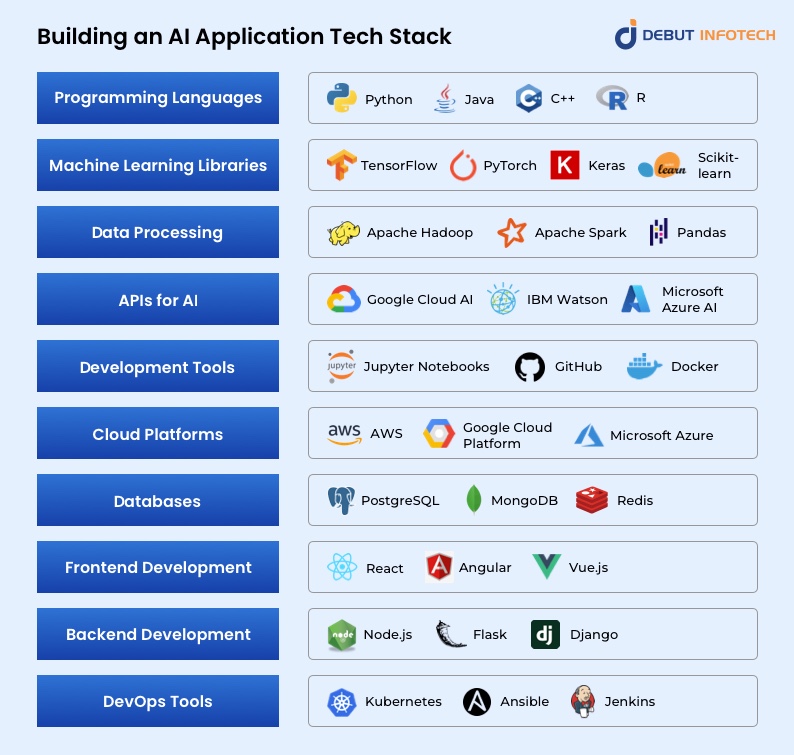
Creating an app powered by artificial intelligence (AI) means you need to use the best and most recent technologies available. This involves choosing the right set of technologies, or “tech stack,” to develop your AI application effectively. It’s important to select the most up-to-date tech stack to ensure your app works smoothly.
Moreover, it’s crucial that the technology you choose aligns with your business requirements. Here are some AI solutions to think about for your app development.
Use-Cases Of AI Technology In Mobile Apps Development
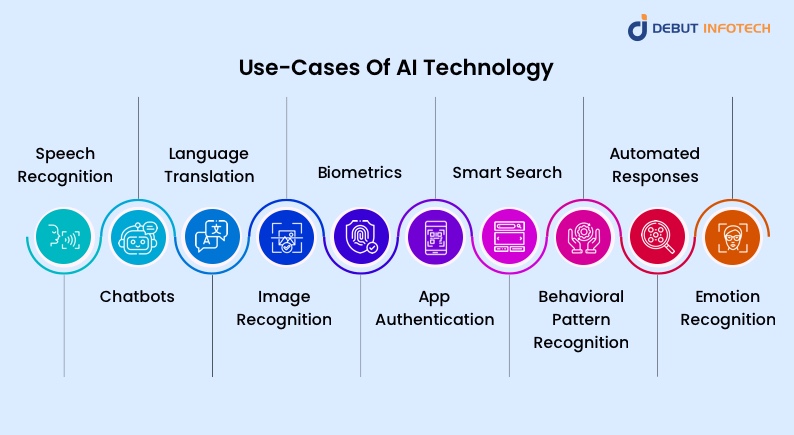
Artificial Intelligence can be integrated into any program, regardless of whether it is being developed for iOS or Android. Artificial Intelligence elevates your mobile application by capturing users’ attention and providing your company with a competitive advantage.
By using the automation technique, even the application development process is made simpler. AI can be utilised and integrated into applications in a variety of ways. Here’s a brief examination of the same.
- Speech Recognition
Imagine talking to your phone and it understands exactly what you’re saying—this is speech recognition. Apps like Siri and Cortana use this technology to listen to your voice commands. Essentially, they translate your spoken words into a format that computers can understand. This makes using gadgets easier and more interactive, as you can simply speak to them instead of typing.
- Chatbots
Chatbots are like virtual helpers in websites or apps. They can chat with you, answer your questions, or help you fill out forms online. This AI feature is fantastic for businesses because it can provide instant answers to customers any time of the day. It’s like having a customer service assistant who never sleeps, ensuring users get the help they need right away.
- Language Translation
Ever wished you could understand or speak another language instantly? That’s what the language translation feature in some apps can do. It’s an AI tool that can translate words from one language to another in real-time. This is super useful for businesses that work with people from different parts of the world, making communication smooth and breaking down language barriers.
- Image Recognition
Imagine being able to search the web by using a photo instead of words. That’s what image recognition technology allows us to do. By using a branch of AI known as computer vision, the system can look at a picture you provide, compare it to a vast library of images it knows about, and find matches or related items. This makes searching for things online using images super accurate and handy, especially when you don’t know the name of what you’re looking for.
- Biometrics
AI has made it way easier to recognize and understand human characteristics and behavior. Now, identifying people based on their physical or behavioral attributes, like the way they look, move, or sound, is simpler than ever. This technology enables cool features like controlling devices with gestures or recognizing someone’s voice, enhancing security and user experience in many areas of our lives.
- App Authentication
AI has given a big boost to keeping our mobile apps more secure. It acts like a vigilant guard, protecting users from potential cyber threats. By monitoring how the app is being used, AI can spot unusual activities that might signal a hacker’s attempt to break in. If something odd is detected, it can lock down access and even alert the user to the potential danger. Integrating image recognition and biometric data makes this security even tighter, ensuring that only the right person can access sensitive information.
- Smart Search
Everyone loves a search feature that can guide them exactly to what they need, helping apps keep users coming back. But AI has taken search functions to a whole new level. Now, you can search using images or your voice, and even get suggestions for what you’re looking for as you type, thanks to AI understanding and predicting your needs. This smart search capability not only makes finding things faster but also significantly boosts how much users engage with an app.
- Automated Responses
Imagine you send a message and get an instant reply, like magic. That’s what automated responses do! They’re like virtual assistants that can answer questions without a human needing to type out each reply. This is perfect for when businesses want to set up a system that automatically talks to customers, answering common questions instantly. For instance, if you ask about store hours, the AI can provide an answer right away, making things faster and smoother.
- Behavioral Pattern Recognition
This is like having a super smart friend who remembers all your likes and dislikes and uses that information to help you learn new things. AI can observe how you use an app—what you click on, the time you spend on certain topics—and guess what you might like to learn next. Educational apps use this to tailor lessons just for you. A popular language-learning app, Duolingo, uses this AI feature to make learning more personalized and effective.
- Emotion Recognition
This AI feature is like a mood ring for the digital age. It can figure out how you’re feeling just by analyzing your voice or the look on your face. Music apps really love this technology because it helps them play songs that match your mood. If you’re feeling happy, it might play upbeat songs, or if you’re sad, something more soothing. The app uses smart tech to “listen” to your voice or “see” your face, understanding your emotions, and then suggests music that fits how you’re feeling right now.
What Advantages Business Can Get From Developing AI Apps?
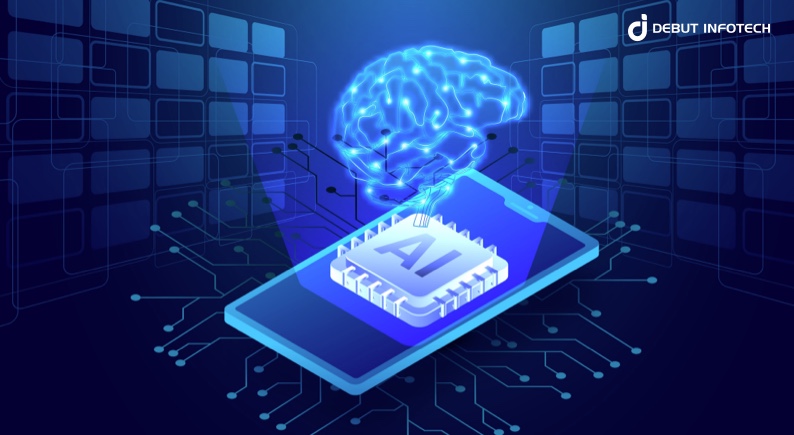
Here are some key benefits of developing an AI application:
- Data-Centric Approach
AI applications thrive on vast amounts of data to function effectively. By harnessing data from diverse sources like websites, IoT devices, and user interactions, these applications can refine their algorithms to enhance user experiences. This constant data analysis helps the app adapt and evolve, staying relevant to user needs.
- Enhanced Security Features
Initially, facial recognition technologies faced challenges like sensitivity to lighting or obstructions like glasses. AI advancements have greatly improved these features, enabling more reliable security measures across devices. Now, most smartphones efficiently use facial recognition, offering users quick and secure access to their devices.
- Consumer Behavior Insights
AI and Machine Learning excel in analyzing detailed user data—such as age, gender, location, and preferences—to tailor experiences and predict behaviors. This deep understanding is invaluable for crafting targeted marketing strategies that resonate with the intended audience, thus enhancing campaign effectiveness.
- Seamless Language Translation
AI applications can now offer real-time language translation without the need for an internet connection, bridging communication gaps instantly. These apps adjust translation latency, ensuring that conversations flow smoothly with minimal delay, enhancing communication across language barriers.
- Advanced Search Capabilities
AI enhances search functionality within apps by integrating image and voice recognition technologies. An example is Google Lens, which allows users to take a photo of an item and instantly receive information about it. This level of search efficiency significantly enhances user interaction and convenience.
- Informed Decision-Making
AI applications analyze user behavior to provide insights that aid business decision-making. By understanding consumer preferences and actions, businesses can tailor their approaches to better meet customer needs, potentially boosting sales and revenue.
- Efficient Automated Responses
AI enhances customer service by enabling automated replies within apps. This feature supports immediate interaction with users, providing quick answers to their inquiries and improving overall customer satisfaction. Major platforms like Google and Facebook utilize this technology to maintain high levels of user engagement.
- Logical Problem Solving
AI-driven apps use automated reasoning to solve complex problems and make logical decisions, often outperforming humans in precision tasks like chess or stock trading. Transportation apps like Ola and Uber employ AI to optimize driver assignments and fare calculations, enhancing operational efficiency.
- High Responsiveness
A responsive AI application quickly learns from user inputs, adapting its functions to better serve and engage customers. The ability to respond dynamically to user interactions makes these apps more intuitive and enjoyable to use.
- Cost and Time Efficiency
AI-powered applications save time and money by preemptively analyzing user behavior to avoid inefficient decisions. This proactive approach reduces errors and enhances efficiency, allowing both users and businesses to achieve their objectives more effectively.
How To Build An AI App: A Step-By-Step Process

Step 1: Identifying the Problem
Before beginning the development of an AI application, the first and perhaps most crucial step is to clearly identify the problem that needs solving. This involves a deep understanding of the desired functionalities and processes within the app where AI could be implemented. Ask yourself: What outcomes are you aiming for with AI integration? How will this technology improve or transform your current processes? What specific benefits are you expecting to achieve? Answering these questions helps in defining clear product requirements.
The process of problem identification doesn’t just aid in conceptual clarity but also directs the technical scope of the project. It helps developers and project managers understand the purpose and potential impact of the product, which in turn influences decisions regarding the technological framework and tools required. At this stage, it’s also important to:
- Define the team composition, which should include a balance of roles from project managers and business analysts to data scientists and backend developers. This diverse team will tackle various aspects of the app from multiple angles, ensuring a well-rounded approach.
- Organize meetings to discuss timelines and workflows with all stakeholders involved, ensuring everyone is aligned and aware of their responsibilities.
- Begin exploring the data requirements necessary for building robust AI/ML models, including where this data will come from and how it will be accessed.
Step 2: Data Preparation
Data is the backbone of any AI application. For AI algorithms to function effectively, they require large volumes of high-quality data. The preparation of this data is a multi-step process that needs careful attention:
- Collection: Data must be gathered from various sources, which could include user interactions, IoT devices, online repositories, etc. This data forms the raw material from which insights and functionalities are derived.
- Labeling: Particularly in supervised learning models, data needs to be labeled accurately. This is often done by a dedicated AI labeling team, which may use tools specifically designed for AI and ML applications.
- Cleaning and Verification: The collected data must be checked for errors, missing values, or inconsistencies. This step is critical as it ensures the reliability of the data fed into the AI models.
- Annotation and Highlighting: Data is annotated and highlighted using specialized tools to make it usable for training AI models.
- Selection and Storage: Once processed, data must be carefully selected, organized, and stored in a manner that makes it easily accessible for training and operational use.
This preparation is critical not only for the accuracy of the AI models but also for their efficiency and effectiveness in real-world applications.
Step 3: Choosing an Algorithm
The heart of an AI system lies in its algorithms, which determine how effectively it can interpret data and make decisions. The choice of algorithm depends heavily on the type of learning the app requires:
- Supervised Learning: This type involves training the AI with a dataset that includes input-output pairs. It learns to predict the output from the input data. Algorithms used here include SVM (Support Vector Machine), Logistic Regression, and others. These are suitable for tasks like predicting user behavior or financial forecasting.
- Unsupervised Learning: Unlike supervised learning, unsupervised learning does not use labeled data. It’s used for exploring data structures, clustering, and finding associations within data. Algorithms for unsupervised learning help in identifying hidden patterns without preassigned labels.
The selection of the right algorithm is a critical decision that affects every aspect of AI application performance. It requires a solid understanding of both the algorithms available and the specific needs of the application. A well-chosen algorithm not only enhances the capability of the AI system but also ensures that it can operate efficiently and provide actionable insights or solutions to the identified problem.
Step 4: Training the Algorithms
Once an algorithm is chosen, its effectiveness is confirmed through rigorous training and continuous refinement to reach the desired accuracy. This phase involves no fixed standards for accuracy; rather, the algorithm must consistently perform well within the established framework. As AI systems are heavily reliant on data, the diversity and quality of the data greatly influence the model’s performance.
Extensive training of the algorithm is crucial—it enhances the system’s efficiency, reduces costs in the long run, and can provide a competitive edge in the marketplace. This step requires significant investment in time and resources, but is critical for the success of any AI application.
Step 5: Selecting the Appropriate Programming Language
The construction of an AI system necessitates a precise understanding of requirements and selecting the optimal programming language tailored to those needs. Various programming languages have distinct capabilities; some are better suited for handling large datasets, while others are preferred for tasks involving natural language processing.
The choice depends on the specific demands of your project and understanding each language’s strengths and limitations. This decision is foundational, as the right programming language can significantly enhance the intuitiveness and effectiveness of the AI system.
Step 6: Choosing the Right Platform
Selecting the right platform is pivotal when developing AI applications, as it supports the integration and deployment of intelligent algorithms. Modern AI platforms and APIs offer built-in capabilities for deep learning, neural networks, and natural language processing, simplifying the creation of complex AI functionalities. Key considerations in this step include:
- Choosing the type of cloud environment, such as a hybrid cloud.
- Understanding data storage locations and who owns the data.
- Considering the limitations imposed by the chosen programming language.
- Checking the availability of necessary APIs in your operating region.
- Evaluating the overall costs associated with the AI development lifecycle.
These platforms often come provided by major cloud services, which also include ready-to-use solutions for image, speech, and language recognition, alongside more complex machine learning algorithms. The choice of platform can influence not just the development process but also the scalability and maintenance of the AI application.
Step 7: Final Development
The final development of an AI-driven application incorporates elements common to traditional software creation, with some unique nuances specific to AI, such as following the CRISP-DM process for data mining. Key components of this phase include:
- Architecture Design: Crafting the overall structure of the AI solution to ensure it meets technical and business requirements.
- User Interface Design: Developing the interface through which users will interact with the AI application, ensuring it is intuitive and user-friendly.
- Frontend and Backend Development: Building the visible parts of the app that users interact with (frontend) and the underlying operations that process data and perform tasks (backend).
During this stage, developers also focus on optimizing the app’s performance, enhancing its functionalities, and ensuring it is scalable for future updates and improvements.
Step 8: Testing, Deployment, and Monitoring
This critical phase begins once development concludes:
- Testing: QA engineers rigorously test the AI application using a combination of automated and manual testing methods to ensure it functions correctly and meets all specifications. Only after comprehensive testing can the application be considered ready for deployment.
- Deployment: The fully tested AI application is then deployed to a production environment where it becomes accessible to users.
- Monitoring and Maintenance: Post-deployment, the application enters a maintenance phase where it is continuously monitored to prevent issues such as data drift, which can affect the performance and accuracy of AI models. The maintenance team must regularly update the data models and concepts the AI uses, as well as implement security patches and software updates to ensure the application remains secure and effective.
This step is crucial for maintaining the reliability and accuracy of the AI system, addressing any potential issues before they impact users, and ensuring the application adapts to new data and evolving user needs.
What Is The Estimated Cost Of AI App Development?

The cost of building ai applications can vary widely based on several factors. Generally, you might expect to pay between $19,000 and $34,000 for app development, though this range can shift depending on several key elements. These factors include the complexity of the app, the technologies used (tech stack), and the geographical location of the development team.
For a more precise estimate, it’s advisable to consult with a development company that has a track record of building similar applications. This can give you a clearer understanding of the costs involved based on your specific requirements.
Considering the cost-effectiveness, you might want to consider partnering with a development company based in India. Developers in India often offer competitive rates compared to their counterparts in other countries, without compromising on the quality of the app. This can be a financially savvy option, especially for startups or businesses looking to maximize their development budget.
Which Industries Can Enhance Operations with AI App Development?
Since its inception in the 1950s, artificial intelligence (AI) has undergone substantial evolution and has recently emerged as a transformational force in a variety of industries.
Businesses are automating repetitive operations, boosting decision-making processes, increasing efficiency, and stimulating creativity by combining AI and machine learning (ML) technologies. AI is being widely used, and several important industries are taking advantage of its ability to completely transform their business processes.
Here are some industries where AI app development is making a significant impact:
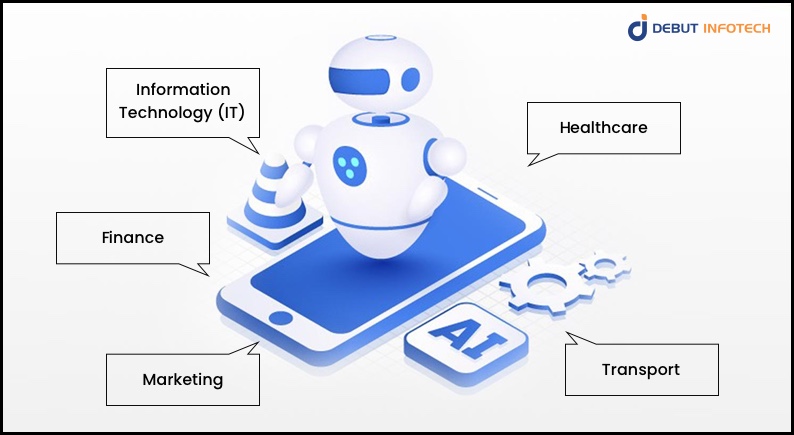
Information Technology (IT)
AI is central to IT, powering advancements in data management, cybersecurity, network performance, and custom software development. AI-driven apps help in predictive maintenance, anomaly detection, and automating repetitive tasks, allowing IT professionals to focus on more strategic activities.
Finance
In finance, AI applications are crucial for fraud detection, risk assessment, and personalized customer services. AI algorithms analyze vast amounts of transaction data to identify unusual patterns, enhance algorithmic trading, and improve customer experience through chatbots and AI-driven advisory services.
Marketing
AI is reshaping marketing strategies by enabling hyper-personalization, targeted advertising, and customer segmentation. AI-driven analytics tools help marketers understand consumer behavior and preferences, optimizing marketing campaigns and increasing return on investment.
Healthcare
AI in healthcare is improving patient outcomes through advanced diagnostics, personalized medicine, and efficient management of medical records. AI applications are being used to develop more accurate diagnostic tools, assist in surgical procedures, and manage patient care with greater precision.
Transport
The transport sector benefits from AI in optimizing logistics, enhancing vehicle safety, and improving traffic management. AI applications facilitate route planning, autonomous vehicle operation, and predictive maintenance, leading to safer and more efficient transport systems.
Bottomline
AI’s deep learning abilities are comparable to human intelligence, making it a valuable asset for promoting corporate success. Its applications are quickly developing in a variety of industries, particularly in improving customer satisfaction, a critical component of gaining a competitive advantage in today’s marketplace.
AI’s adaptability is seen in a variety of industries, from fintech and social media to medical, bringing up new options for innovation and development. However, developing AI solutions is not without its difficulties; it necessitates a high level of knowledge in AI, machine learning, and data science.
Developing an AI application is a sophisticated process that requires more than just a basic understanding of technology. It necessitates partnering with skilled professionals who have a thorough knowledge of the end-to-end development process. For businesses looking to navigate the complexities of AI app creation, selecting the right development partner is essential.
For those contemplating how to create artificial intelligence app, consider reaching out to Debut Infotech’s team of AI experts. We are equipped to deliver AI applications with advanced features, ensuring your AI-powered venture is successful and impactful.
FAQs: How To Develop An AI Application
A. Artificial Intelligence (AI) refers to the simulation of human intelligence in machines that are programmed to think like humans and mimic their actions. The term may also be applied to any machine that exhibits traits associated with a human mind such as learning and problem-solving.
A. To build an AI app, first define its purpose and target audience. Choose suitable AI techniques like machine learning, natural language processing, or computer vision. Collect and preprocess relevant data. Develop the app using programming languages (e.g., Python) and frameworks (e.g., TensorFlow, PyTorch). Finally, test, deploy, and iterate based on user feedback.
A. Building an AI on your own is possible, particularly if you have a background in technology and a good grasp of programming and data science. However, developing sophisticated AI applications typically requires advanced knowledge in machine learning algorithms, data handling, and software development.
A. The time to build an AI app can vary significantly based on the complexity of the app and the technology used. Simple applications might take a few months, while more complex systems could take over a year to develop properly.
A. Machine Learning is a subset of AI focused on building systems that learn from data, identify patterns, and make decisions with minimal human intervention. It’s defined by its ability to improve automatically through experience and by using data to generate insights.
A. Creating an AI program involves defining its purpose, selecting appropriate algorithms (like machine learning or expert systems), and coding in a programming language such as Python. Data collection, preprocessing, model training, and evaluation are key steps. Continuous refinement through testing and feedback improves its performance and adaptability.
A. While it’s feasible to develop an AI app independently, the complexity of the task often necessitates a team that includes not just developers but also data scientists and domain experts. The feasibility largely depends on the individual’s technical skills and the resources available.
A. Developing an AI application typically takes anywhere from a few months to several years, depending on the scope and depth of the project. Smaller projects might be completed quickly, while enterprise-level solutions require more extensive research, testing, and iteration.
Talk With Our Expert
Our Latest Insights
USA
2102 Linden LN, Palatine, IL 60067
+1-708-515-4004
info@debutinfotech.com
UK
Debut Infotech Pvt Ltd
7 Pound Close, Yarnton, Oxfordshire, OX51QG
+44-770-304-0079
info@debutinfotech.com
Canada
Debut Infotech Pvt Ltd
326 Parkvale Drive, Kitchener, ON N2R1Y7
+1-708-515-4004
info@debutinfotech.com
INDIA
Debut Infotech Pvt Ltd
Sector 101-A, Plot No: I-42, IT City Rd, JLPL Industrial Area, Mohali, PB 140306
9888402396
info@debutinfotech.com





Leave a Comment